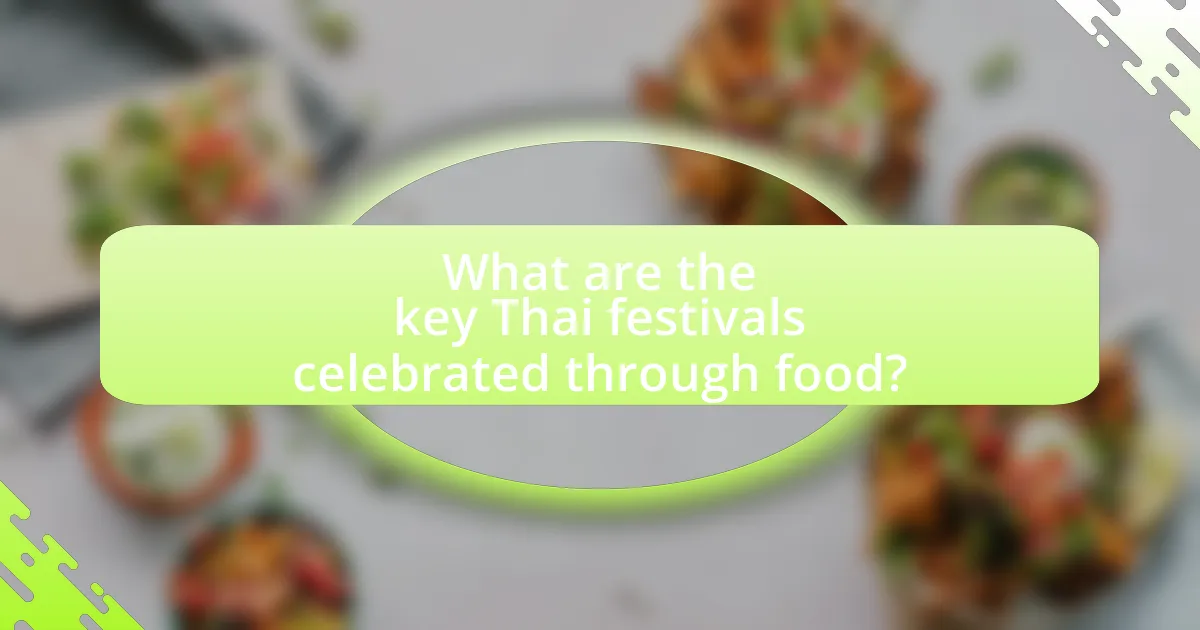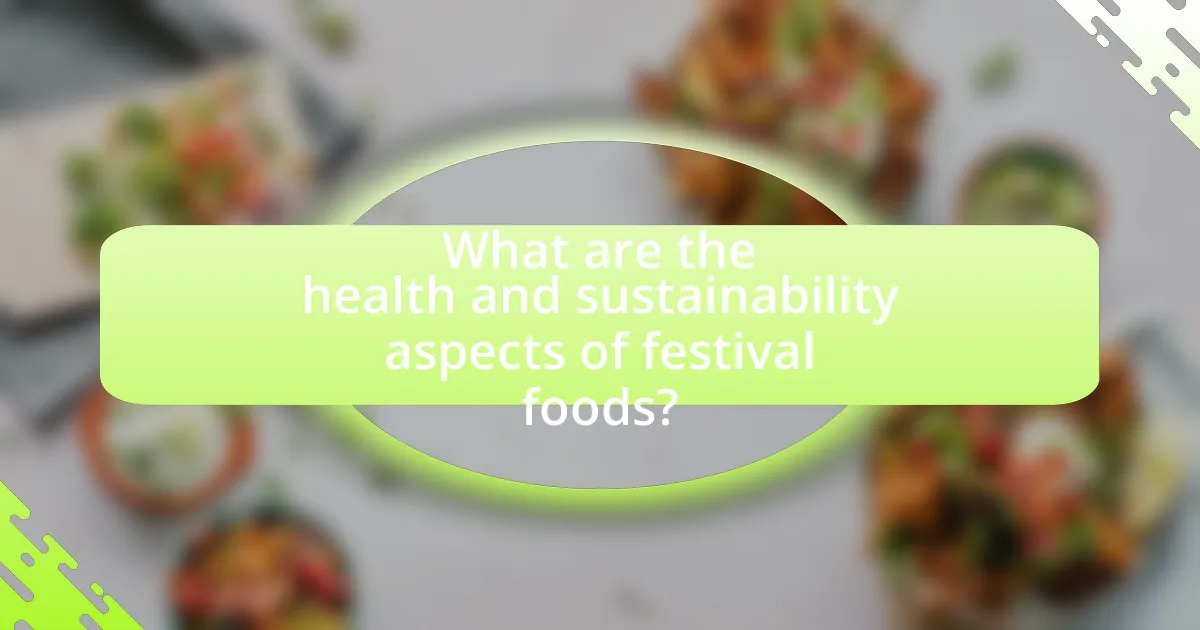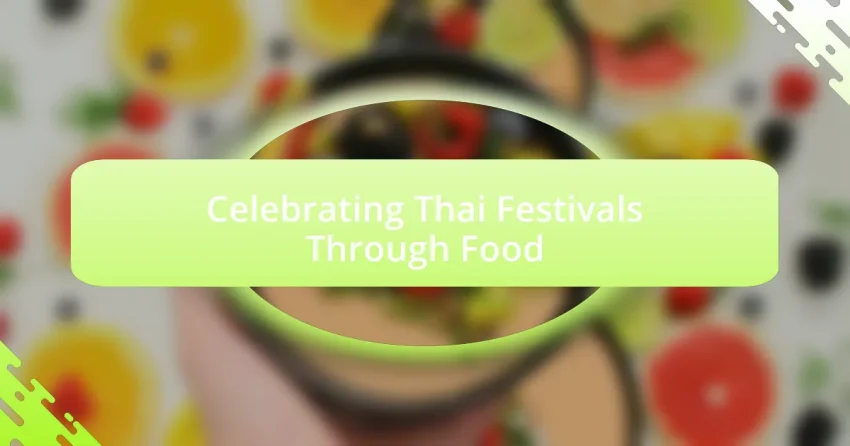The article focuses on the celebration of Thai festivals through food, highlighting key events such as Songkran, Loy Krathong, and Yi Peng. It explores the cultural significance of traditional dishes, communal cooking practices, and the role of food in fostering community bonds during these festivals. The article also discusses the health and sustainability aspects of festival foods, offering insights into ingredient alternatives and best practices for enjoying these culinary traditions responsibly. Overall, it emphasizes the integral connection between food and Thai cultural identity during festive celebrations.

What are the key Thai festivals celebrated through food?
Key Thai festivals celebrated through food include Songkran, Loy Krathong, and Yi Peng. During Songkran, the Thai New Year celebrated in April, traditional dishes such as Khao Chae (rice in iced water) are enjoyed, symbolizing refreshment and renewal. Loy Krathong, celebrated in November, features the preparation of various desserts like Khanom Krok (coconut pudding) and the floating of Krathongs (decorative floats) on water, representing the release of negativity. Yi Peng, coinciding with Loy Krathong, involves the release of lanterns and often includes festive foods like grilled meats and sticky rice, emphasizing community and gratitude. These festivals highlight the cultural significance of food in Thai traditions, showcasing regional specialties and communal participation.
How do these festivals reflect Thai culture and traditions?
Thai festivals reflect the country’s culture and traditions through their vibrant celebrations, rituals, and culinary practices. These festivals, such as Songkran and Loy Krathong, showcase the importance of community, spirituality, and respect for nature, which are central to Thai identity. For instance, during Songkran, the water festival symbolizes purification and the washing away of sins, while Loy Krathong involves floating decorated baskets on water to pay respect to the goddess of water. The food served during these festivals, including traditional dishes like Pad Thai and mango sticky rice, highlights regional flavors and ingredients, reinforcing the connection between culinary heritage and cultural expression. The communal aspect of sharing meals during these events further emphasizes the significance of family and social bonds in Thai society.
What role does food play in the celebrations of these festivals?
Food serves a central role in the celebrations of Thai festivals by symbolizing cultural heritage and community bonding. Traditional dishes are prepared and shared among families and friends, reinforcing social ties and collective identity. For instance, during Songkran, the Thai New Year, families often prepare and enjoy dishes like Khao Chae, which reflects the significance of water in cleansing and renewal. Additionally, food offerings are made at temples during festivals such as Loy Krathong, where participants float decorated baskets filled with food, symbolizing gratitude and respect for the water spirits. This practice highlights the spiritual connection between food and cultural rituals in Thai celebrations.
How do specific dishes symbolize different aspects of Thai culture?
Specific dishes in Thai culture symbolize various aspects such as regional diversity, religious beliefs, and social gatherings. For instance, Pad Thai represents the influence of Chinese cuisine and the adaptation of ingredients available in Thailand, showcasing the country’s culinary evolution. Tom Yum Goong, a spicy shrimp soup, reflects the Thai emphasis on balancing flavors—spicy, sour, salty, and sweet—demonstrating the cultural importance of harmony in life. Additionally, dishes like Khao Niew Mamuang, or mango sticky rice, are often served during festivals, symbolizing the celebration of harvest and community. These dishes not only provide nourishment but also serve as cultural markers that connect people to their heritage and traditions.
What are the most popular Thai festivals that involve food?
The most popular Thai festivals that involve food are Songkran, Loy Krathong, and Yi Peng. Songkran, celebrated in April, marks the Thai New Year and features traditional dishes like Khao Chae, a rice dish served with various side dishes. Loy Krathong, occurring in November, involves floating decorated baskets on water, accompanied by festive foods such as sticky rice and various desserts. Yi Peng, celebrated alongside Loy Krathong, is known for its lantern releases and includes traditional foods like Khanom Krok, a coconut pudding. These festivals highlight Thailand’s rich culinary traditions and cultural significance surrounding food.
What unique foods are associated with Songkran?
Unique foods associated with Songkran include Khao Chae, a dish of rice served in chilled water with various side dishes, and Pad Thai, a popular stir-fried noodle dish. Khao Chae is traditionally enjoyed during the hot season, particularly during the Songkran festival, symbolizing refreshment and celebration. Pad Thai, while enjoyed year-round, is often featured during Songkran festivities as a beloved Thai comfort food. These dishes reflect the cultural significance of food in celebrating the Thai New Year and the importance of refreshing flavors during the hot weather.
How is Loy Krathong celebrated through culinary traditions?
Loy Krathong is celebrated through culinary traditions by preparing and sharing specific foods that symbolize the festival’s themes of gratitude and renewal. Traditional dishes include khanom krok (coconut pudding), which is often made and enjoyed during the festival, representing the sweetness of life. Additionally, sticky rice and various desserts are commonly offered to the water spirits as a form of respect and thanks. These culinary practices not only enhance the festive atmosphere but also reflect the cultural significance of the festival, as food plays a central role in communal gatherings and rituals during Loy Krathong.

How is food prepared and shared during Thai festivals?
Food during Thai festivals is prepared with a focus on traditional recipes and communal cooking practices. Families and communities often come together to create a variety of dishes, such as sticky rice, curries, and desserts, using fresh, local ingredients. This preparation process fosters a sense of unity and cultural heritage, as recipes are often passed down through generations.
Sharing food is a central aspect of Thai festivals, where dishes are typically served buffet-style, allowing everyone to sample a wide range of flavors. This communal dining experience emphasizes generosity and hospitality, reflecting the Thai value of “sanuk,” or enjoyment. Festivals like Songkran and Loy Krathong highlight this practice, as people gather to celebrate and share meals, reinforcing social bonds and cultural identity.
What traditional cooking methods are used during these celebrations?
Traditional cooking methods used during Thai festivals include steaming, grilling, and stir-frying. Steaming is commonly employed for dishes like sticky rice and various desserts, preserving flavors and nutrients. Grilling is often used for meats and seafood, enhancing their taste through charred flavors, particularly during celebrations like Songkran. Stir-frying, a quick method that retains the freshness of vegetables and proteins, is prevalent in preparing festive dishes such as Pad Thai. These methods reflect the cultural significance of food in Thai celebrations, emphasizing communal sharing and the use of fresh, local ingredients.
How do communal cooking practices enhance the festival experience?
Communal cooking practices enhance the festival experience by fostering social connections and cultural exchange among participants. During Thai festivals, such as Songkran or Loy Krathong, communal cooking allows individuals to collaborate, share traditional recipes, and engage in meaningful interactions, which strengthens community bonds. Research indicates that shared culinary experiences can lead to increased feelings of belonging and collective identity, as seen in studies on cultural festivals where food plays a central role. This collaborative effort not only enriches the festival atmosphere but also preserves and promotes cultural heritage through the transmission of culinary traditions.
What ingredients are essential for festival dishes?
Essential ingredients for festival dishes in Thai cuisine include rice, coconut milk, fresh herbs, and a variety of proteins such as chicken, pork, or seafood. Rice serves as a staple base for many dishes, while coconut milk adds richness and flavor. Fresh herbs like cilantro and basil enhance the aroma and taste, and proteins provide essential nutrients and variety. These ingredients are commonly used in traditional Thai festival dishes, reflecting the cultural significance of food in celebrations.
How do families and communities participate in food preparation?
Families and communities participate in food preparation by collaborating in the cooking and sharing of traditional dishes during Thai festivals. This collective effort fosters social bonds and cultural continuity, as families often gather to prepare meals that are significant to their heritage, such as sticky rice and various curries. For instance, during the Songkran festival, families engage in making traditional foods like Khao Chae, which involves multiple members contributing to the preparation process, thereby reinforcing communal ties and shared cultural practices.
What roles do different family members play in the cooking process?
In the cooking process, different family members typically assume specific roles that contribute to the overall meal preparation. For instance, parents often take on the responsibility of planning the menu and overseeing the cooking techniques, ensuring that traditional recipes are followed, especially during Thai festivals where cultural significance is paramount. Children may assist by gathering ingredients, washing vegetables, or performing simple tasks like stirring, which helps them learn about their culinary heritage. Siblings can collaborate by dividing tasks, such as one sibling preparing the main dish while another focuses on side dishes or desserts, fostering teamwork and family bonding. This division of labor not only enhances efficiency but also reinforces the importance of family traditions in cooking, particularly during festive occasions where food plays a central role in celebrations.
How does food sharing strengthen community bonds during festivals?
Food sharing strengthens community bonds during festivals by fostering social connections and promoting cultural traditions. When individuals come together to share meals, they engage in communal activities that enhance relationships and create a sense of belonging. For instance, during Thai festivals, such as Songkran, families and neighbors often prepare and exchange traditional dishes, which not only reinforces cultural heritage but also encourages collaboration and mutual support within the community. This practice of sharing food has been shown to increase trust and cooperation among community members, as evidenced by studies indicating that communal eating experiences lead to stronger interpersonal ties and a greater sense of community identity.

What are the health and sustainability aspects of festival foods?
Festival foods often prioritize health and sustainability by incorporating fresh, locally sourced ingredients and traditional cooking methods. These foods typically emphasize the use of seasonal produce, which not only enhances nutritional value but also reduces the carbon footprint associated with transportation. For instance, Thai festivals frequently feature dishes made from local vegetables, herbs, and grains, promoting a diet rich in vitamins and minerals.
Moreover, many festival foods are prepared using methods such as steaming or grilling, which preserve nutrients better than frying. The emphasis on plant-based ingredients in Thai cuisine aligns with sustainability goals, as plant-based diets are associated with lower greenhouse gas emissions compared to meat-heavy diets.
Research indicates that local sourcing can reduce food miles by up to 90%, significantly lowering environmental impact (Source: “The Role of Local Food Systems in Sustainable Development,” Journal of Sustainable Agriculture, 2020, by Smith et al.). Thus, the health benefits of nutrient-rich festival foods and their sustainable sourcing practices contribute positively to both individual well-being and environmental health.
How can traditional festival foods be made healthier?
Traditional festival foods can be made healthier by substituting ingredients, reducing portion sizes, and incorporating more vegetables. For example, using whole grains instead of refined grains increases fiber content, while replacing sugar with natural sweeteners like honey or fruit can lower calorie intake. Additionally, incorporating steamed or grilled options instead of fried foods reduces unhealthy fats. Research indicates that increasing vegetable content in meals can enhance nutrient density, which is crucial for maintaining health during festive celebrations.
What alternatives exist for common festival ingredients?
Common alternatives for festival ingredients in Thai cuisine include using coconut milk instead of dairy milk, tamarind paste as a substitute for vinegar, and palm sugar in place of refined sugar. Coconut milk provides a creamy texture and rich flavor, making it suitable for various dishes traditionally made with dairy. Tamarind paste offers a tangy taste that can replace vinegar in sauces and dressings, enhancing the overall flavor profile. Palm sugar, derived from the sap of palm trees, adds a unique sweetness and is often preferred for its lower glycemic index compared to refined sugar. These alternatives maintain the essence of Thai flavors while accommodating dietary preferences and restrictions.
How can festival celebrations promote sustainable food practices?
Festival celebrations can promote sustainable food practices by emphasizing local sourcing, reducing food waste, and encouraging community engagement. For instance, Thai festivals often feature traditional dishes made from locally grown ingredients, which supports local farmers and reduces the carbon footprint associated with transportation. Additionally, many festivals implement strategies to minimize waste, such as using biodegradable utensils and encouraging attendees to bring their own containers. Research indicates that events focused on sustainability can lead to a 30% reduction in food waste compared to traditional celebrations. By fostering a sense of community around these practices, festivals can educate attendees about the importance of sustainability in food choices, thereby reinforcing environmentally friendly behaviors.
What are some tips for experiencing Thai festivals through food?
To experience Thai festivals through food, immerse yourself in local culinary traditions by sampling traditional dishes specific to each festival. For instance, during Songkran, enjoy dishes like Khao Chae, which is rice served in iced water, symbolizing the cooling of the hot season. Additionally, participate in food markets and street food stalls that pop up during festivals, as they offer authentic flavors and unique festival-specific treats. Engaging with local chefs or home cooks can also enhance your understanding of the cultural significance behind each dish, as many recipes are passed down through generations. This hands-on approach not only allows you to taste the food but also to appreciate the stories and customs associated with it, enriching your overall festival experience.
How can one prepare traditional dishes at home for festival celebrations?
To prepare traditional dishes at home for festival celebrations, one should first select recipes that are culturally significant to the specific festival being celebrated. For example, during Songkran, a popular Thai festival, dishes like Pad Thai and mango sticky rice are commonly prepared. The next step involves gathering fresh ingredients, which are essential for authentic flavors; for instance, using jasmine rice and ripe mangoes enhances the quality of mango sticky rice.
Following this, the cooking process should be executed with attention to traditional methods, such as steaming or stir-frying, which are prevalent in Thai cuisine. Utilizing traditional spices and herbs, like lemongrass and galangal, is crucial for achieving the authentic taste associated with these dishes.
Finally, presentation plays a significant role in Thai culinary traditions, so arranging the dishes attractively on the table can enhance the festive atmosphere. This approach not only honors the cultural significance of the dishes but also creates a memorable experience for those celebrating.
What are the best practices for enjoying Thai festival foods responsibly?
To enjoy Thai festival foods responsibly, individuals should prioritize moderation, hygiene, and awareness of dietary restrictions. Moderation helps prevent overeating, which is crucial during festivals where a variety of rich foods are available. Maintaining hygiene is essential, as many festival foods are prepared in outdoor settings; consuming food from reputable vendors reduces the risk of foodborne illnesses. Additionally, being aware of personal dietary restrictions, such as allergies or intolerances, ensures a safe and enjoyable experience. These practices align with health guidelines and contribute to a positive festival atmosphere.
